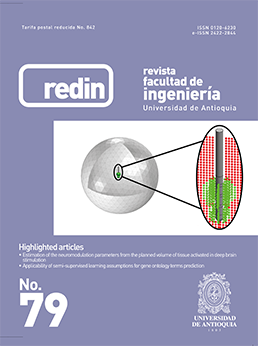Automatic segmentation of lizard spots using an active contour model
DOI:
https://doi.org/10.17533/udea.redin.n79a04Keywords:
active contours, gamma correction, morphological filters, spots segmentation, Diploglossus millepunctatusAbstract
Animal biometrics is a challenging task. In the literature, many algorithms have been used, e.g. penguin chest recognition, elephant ears recognition and leopard stripes pattern recognition, but to use technology to a large extent in this area of research, still a lot of work has to be done. One important target in animal biometrics is to automate the segmentation process, so in this paper we propose a segmentation algorithm for extracting the spots of Diploglossus millepunctatus, an endangered lizard species. The automatic segmentation is achieved with a combination of preprocessing, active contours and morphology. The parameters of each stage of the segmentation algorithm are found using an optimization procedure, which is guided by the ground truth. The results show that automatic segmentation of spots is possible. A 78.37 % of correct segmentation in average is reached.
Downloads
References
J. Unar, W. Seng and A. Abbasi, “A review of biometric technology along with trends and prospects”, Pattern Recognition, vol. 47, no. 8, pp. 2673-2688, 2014.
A. Ardovini, L. Cinque and E. Sangineto, “Identifying elephant photos by multi-curve matching”, Pattern Recognition, vol. 41, no. 6, pp. 1867-1877, 2008.
R. Sherley, T. Burghardt, P. Barham, N. Campbell and I. Cuthill, “Spotting the difference: towards fullyautomated population monitoring of African penguins Spheniscus demersus”, Endangered Species Research, vol. 11, pp. 101-111, 2010.
H. Kühl and T. Burghardt, “Animal biometrics: quantifying and detecting phenotypic appearance”, Trends in Ecology & Evolution, vol. 28, no. 7, pp. 432-441, 2013.
J. Li, D. Tohl, S. Randhawa, L. Shamimi and C. Bull, “Non-invasive Lizard Identifcation using Signature Curves”, in TENCON, IEEE Region 10 Internationa Conference, Singapore, Singapore, 2009, pp. 1-5.
M. López, “The lizards of Malpelo (Colombia): some topics on their ecology and threats”, Caldasia, vol. 28, no. 1, pp. 129-134, 2006.
P. Zeeuw, E. Pauwels, E. Ranguelova, D. Buonantony and S. Eckert, “Computer assisted photo identifcation of Dermochelys coriacea”, in Int. Conference on Pattern Recognition (ICPR), Germany, Berlin, 2010, pp. 165-172.
M. Kelly, “Computer-aided photograph matching in studies using individual identifcation: an example from Serengeti cheetahs”, Journal of Mammalogy, vol. 82, no. 2, pp. 440-449, 2001.
D. Bolger, T. Morrison, B. Vance, D. Lee and H. Farid, “A computer‐assisted system for photographic mark– recapture analysis”, Methods in Ecology and Evolution, vol. 3, no. 5, pp. 813-822, 2012.
A. Bell, G. Herberich, D. Meyer, A. Bocking and T. Aach, “Segmentation and detection of nuclei in silver stained cell specimens for early cancer diagnosis”, in IEEE International Conference on Image Processing (ICIP), San Antonio, USA, 2007, pp. 49-52.
J. Borovec, “Fully automatic segmentation of stained histological cuts”, in International Student Conference on Electrical Engineering, Czech Republic, Prague, 2013, pp. 1-7.
M. Veta, A. Huisman, M. Viergever, P. Diest and J. Pluim, “Marker-controlled watershed segmentation of nuclei in H&E stained breast cancer biopsy images”, in IEEE International Symposium on Biomedical Imaging: From Nano to Macro, Chicago, USA, 2011, pp. 618-621.
A. Mouelhi, M. Sayadi, F. Fnaiech, K. Mrad and K. Romdhane, “Automatic image segmentation of nuclear stained breast tissue sections using color active contour model and an improved watershed method”, Biomedical Signal Processing and Control, vol. 8, no. 5, pp. 421-436, 2013.
M. Kass, A. Witkin and D. Terzopoulos, “Snakes: Active contour models”, International Journal of Computer Vision, vol. 1, no. 4, pp. 321-331, 1988.
A. Blake and M. Isard, Active contours, 1st ed. Cambridge, UK: Springer, 1998.
T. Chan and L. Vese, “Active contours without edges”, IEEE Transactions on Image Processing, vol. 10, no. 2, pp. 266-277, 2001.
W. Gang et al., “A leaf recognition algorithm for plant classifcation using probabilistic neural network”, in IEEE International Symposium on Signal Processing and Information Technology, Giza, Egypt, 2007, pp. 11-16.
M. Farshbaf and H. Hassanpour, “A locally-adaptive approach for image gamma correction”, in 10th International Conference on Information Sciences Signal Processing and their Applications (ISSPA), Kuala Lumpur, Malaysia, 2010, pp. 73-76.
G. Dominguez, “Semi-automatic generation of accurate ground truth data in video sequences”, in International Conference on Advances in Computing, Communications and Informatics (ICACCI), New Delhi, India, 2014, pp. 310-315.
D. Powers, “Evaluation: from precision, recall and F-measure to ROC, informedness, markedness and correlation”, Journal of Machine Learning Technologies, vol. 2, no. 1, pp. 37-63, 2011.
Downloads
Published
How to Cite
Issue
Section
License
Copyright (c) 2016 Revista Facultad de Ingeniería Universidad de Antioquia

This work is licensed under a Creative Commons Attribution-NonCommercial-ShareAlike 4.0 International License.
Revista Facultad de Ingeniería, Universidad de Antioquia is licensed under the Creative Commons Attribution BY-NC-SA 4.0 license. https://creativecommons.org/licenses/by-nc-sa/4.0/deed.en
You are free to:
Share — copy and redistribute the material in any medium or format
Adapt — remix, transform, and build upon the material
Under the following terms:
Attribution — You must give appropriate credit, provide a link to the license, and indicate if changes were made. You may do so in any reasonable manner, but not in any way that suggests the licensor endorses you or your use.
NonCommercial — You may not use the material for commercial purposes.
ShareAlike — If you remix, transform, or build upon the material, you must distribute your contributions under the same license as the original.
The material published in the journal can be distributed, copied and exhibited by third parties if the respective credits are given to the journal. No commercial benefit can be obtained and derivative works must be under the same license terms as the original work.










 Twitter
Twitter